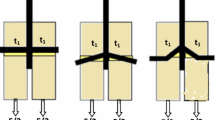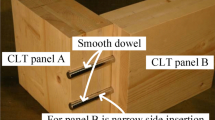Abstract
Our study focuses on predicting the ultimate short-term load carrying capacity of timber-to-timber connections with dowel-type fasteners. The wide range of possible configurations in practice makes the resolution of these values by tests unrealistic. Moreover, different current regulations do not consider some specific failure mechanisms. In many countries, the reduction of resistance involved by this phenomenon is taken into account by considering an effective number of dowels (nef) smaller than the actual number of dowels (n) in the connection. However, these different regulations disagree on the values of nef and on other points (spacing, partial coefficient of security, formulas). These discrepancies in design rules invite the fundamental research on this topic and, therefore, new methods are sought in order to estimate the load carrying capacities of the connections. In the light of these, our approach consists of predicting the load carrying capacity with the neural network numerical tool. The results obtained by this analysis tool are satisfactory, although the model remains complex. Subsequently, we focus on the simplification of this numerical model with classical regression techniques in order to implement it in a design code.









Similar content being viewed by others
References
Canadian Standards Association (1994) Engineering design in wood (limit states design). A national standard of Canada. CSA 086:1–94
Cointe A (2003) Prévision de résistances d’assemblages bois par organes multiples à l’aide des réseaux de neurones. PhD Thesis, Division of Mechanics, Bordeaux I University
Cointe A, Rouger F (2001) Predicting the load carrying capacity of dowel-type connections by using the neural network approach. International Rilem Symposium on Joints in Timber Structures PRO 22 Stuttgart, Germany, pp 51–61
Jorissen A (1998) Double shear timber connections with dowel type fasteners. Delft University Press Mekelweg 4 2628 CD Delft, The Netherlands
Load and Resistance Factor Design (1991) Specification for engineered wood construction. Guidelines for developing reference resistance, LRFD
prEN 1995-1-1, Eurocode 5 (2002) Design of timber structures, part 1-1, general rules and rules for buildings, final draft. Document CEN/TC 250/SC 5:N 195
Vermeyden P (1980) Test on bolted joints. CIB W18 (13-7-7) meeting 13 Otaniemi
Vincent B (1988) Analyse et modélisation du comportement mécanique des assemblages bois boulonnés ou cloués. PhD Thesis, Division of Civil Engineering, CUST, Clermont II University, Clermont-Ferrand
Wilkinson TL (1986) Load distribution among bolts parallel to load. J Struct Eng ASCE 112(4):835–852
Author information
Authors and Affiliations
Corresponding author
Appendix
Appendix
1.1 Notation
The following symbols are used in this paper
- a 1 :
-
Spacing between dowels in a row
- a 2 :
-
Spacing between dowel rows
- a 3 :
-
End distance spacing
- a 4 :
-
Edge distance spacing
- d :
-
Dowel diameter
- f h :
-
Embedment strength of the wood
- f u :
-
Characteristic tensile strength of the metallic dowel
- m :
-
Number of rows
- n :
-
Number of dowels in a row
- n ef :
-
Effective number of dowels
- t 1 :
-
Lateral thickness of wood members
- t 2 :
-
Median thickness of wood member
- α:
-
Angle between the loading and the grain directions
- ρ:
-
Mean density of wood
Rights and permissions
About this article
Cite this article
Cointe, A., Rouger, F. Improving the evaluation of multiple-dowel-type connection strength. Wood Sci Technol 39, 259–268 (2005). https://doi.org/10.1007/s00226-005-0293-5
Received:
Accepted:
Published:
Issue Date:
DOI: https://doi.org/10.1007/s00226-005-0293-5




